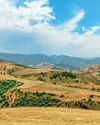
MARJAN DE BLOK readjusts her body weight as she treads along the jetty linking a floating community on a canal off the River IJ. Through the whipping winds, she shouts greetings to many of her neighbours.
On the day I visited in autumn 2021, heavy rains and 80-kilometeran-hour winds put Amsterdam, just a short ferry ride away, on alert. But in the northern neighborhood of Schoonschip, life carried on mostly as usual. De Blok visited with neighbours while the homes glided up and down their steel foundational poles with the movement of the water below.
"It feels like living at the beach, with the water, the saltiness of the air and the seagulls," she says. "But it also feels special because, initially, we were told that building your own neighbourhood, it's just impossible."
A long list of European lawmakers, urban planners, entrepreneurs and citizens have visited Schoonschip to see the real-life manifestation of a once science-fiction idea. De Blok, a Dutch reality-TV director, has shown them Schoonschip's patchwork of environmentally focused social projects: lush floating gardens beloved by the water birds; a community centre featuring floating architecture diagrams; and a nearby on-land vegetable patch. But the homes' industrial-chic design and their immediate proximity to the city, she says, are what surprise visitors most.
Schoonschip can serve as a prototype for the more than 600 million people-close to 10 per cent of the world's population who live near the coast and less than 10 metres above sea level. As the effects of climate change intensify, sea levels are forecast to rise somewhere between 30 and 240 centimetres this century, and storms are expected to increase in frequency and intensity. In the summer of 2021, at least 220 people died in Germany and Belgium from a once-in-400-year rain event. In Zhengzhou, China, 630 millimetres of rain fell in one day, killing nearly 300 people.
This story is from the {{IssueName}} edition of {{MagazineName}}.
Start your 7-day Magzter GOLD free trial to access thousands of curated premium stories, and 9,000+ magazines and newspapers.
Already a subscriber ? Sign In
This story is from the {{IssueName}} edition of {{MagazineName}}.
Start your 7-day Magzter GOLD free trial to access thousands of curated premium stories, and 9,000+ magazines and newspapers.
Already a subscriber? Sign In

Demonstrators by Krishna Reddy
1968 Multicolour viscosity, Print on paper

Notes from Grief Camp
Every summer, more than a hundred children come together to spend a weekend swimming, climbing and canoeing. They also learn to deal with death

Six Places Cheese Lovers Should Visit
Ancient caves, monasteries, and other must-sees for fromage fans

THE LAND OF SUPERCEN TENARIANS
A remote region of Azerbaijan claims to have many extremely long-lived residents. What is their secret, or is it just a myth?

The Whistle Blowers
My grandparents had a distinctive way of communicating

"THE NEXT AIRCRAFT WILL CRASH ON LANDING"
THE JET WAS ALMOST OUT OF FUEL. THE PILOTS' ONLY OPTION WAS A MANOEUVRE NO ONE HAD EVER ATTEMPTED.

The Secrets in our Genes
Genomic sequencing tests can reveal much about your unique physiology. But are they worth it?

GOOD NEWS FROM AROUND THE WORLD
MENTAL HEALTH When her son was arrested last year, Tambudzai Tembo's mind went to dark thoughts of suicide.

Into the Inferno
A gas station owner has seconds to react when a car crashes into a gas pump

THE CLIMATE CHANGERS
THESE PLACES ARE LEADING THE WAY TO A FUTURE FREE OF FOSSIL FUELS